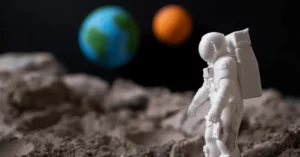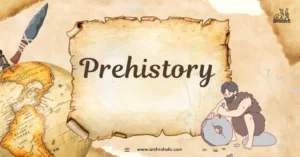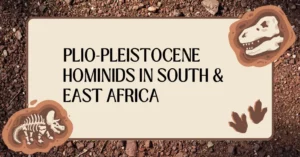AI Answer Evaluation Platform Live Now. Try Free Answer Evaluation Now
Chronology
Scientists have sought to fathom the chronology of the Earth in order to pinpoint the exact dates of each key event in our geological, biological, and cultural history since far earlier than the Age of Enlightenment. Scholars have tried to date every biblical event and define a chronology from savagery to civilization, from creation to the appearance of the first animal, then to the emergence of the first people, even when the only science we had was religious literature and the west believed the world was created in 4004 BC [1].

The pre-enlightenment view of our geological and cultural past, although disproved and questioned today, served as the foundation for many disciplines. Our methods, accuracy, and tools for locating the historical information we need advance with technology as well. Scholars have attempted to date each biblical event and define a chronology from savagery to civilization, from creation to the appearance of the first animal, then to the emergence of the first people, even when the only science we had was religious literature and the west believed the world was created in 4004 BC.
All current dating techniques may be categorized using absolute dating and relative dating. Although the former provides a date based on ties to other objects, the latter offers a date based on a numerical age (for example, this artifact is 5000 years old) (for example, this geological layer formed before this other one). For reenacting historical events, from the most recent to a time before humanity and civilization, both techniques are crucial.
The methodologies provided here include some tried-and-true approaches from the early days of exploring previous geological, geographic, anthropological, and archaeological processes. The bulk of them are interdisciplinary, although others are by definition confined to a single subject. Although no system or technique is perfect, when used correctly, they can and have helped historians piece together the past and deal with some of their field’s most difficult challenges.
Since the Enlightenment, and maybe much earlier, scientists have attempted to understand the Earth’s chronology in order to determine the precise dates of each key event in our geological, biological, and cultural history. Scholars have attempted to date each biblical event and define a chronology from savagery to civilization, from creation to the appearance of the first animal, then to the emergence of the first people, even when the only science we had was religious literature and the west believed the world was created in 4004 BC[2].
Despite being refuted and contested today, the pre-enlightenment understanding of our geological and cultural history served as the basis for numerous disciplines. As technology develops, so do our search techniques, accuracy, and resources for finding the historical data we need.
Absolute dating and relative dating may be used to classify all current dating methods. The latter offers a date based on ties to other objects, whereas the former (for example, this artifact is 5000 years old) provides a date based on a numerical age (for example, this geological layer formed before this other one). Both approaches are crucial for reenacting historical events, from the most recent to a period before humans and even complex life, and researchers occasionally combine both approaches to establish a date.
The strategies presented here include some tried-and-true techniques from the early days of investigating prior geological, geographic, anthropological, and archaeological processes. The majority of them are multidisciplinary; however, some are by definition confined to a certain field. Although neither a system nor a technique is perfect, when used properly, they can and have helped historians piece the past together and address some of their field’s most challenging issues.
What sciences require these dating methods?
These dating techniques may be used in any scientific field where chronology is significant. They may provide a variety of information, including their age and the order in which certain surgeries took place. This often involves:
The study of people, including their contemporary and historical behaviors, is known as anthropology. According to anthropological dating techniques, a settlement’s relative time periods, human activity, such as the beginnings of agriculture, and settlement growth and decline may all be identified.
Archaeology is the study of the physical evidence left by former inhabitants. Archaeologists are also interested in cultural change, anthropological dating techniques, artifact morphology and typology (and evolution, such as the development of stone tools), and these topics. Geology: Below, geography is related to the study of the planet’s geological composition. Thus, dates may be necessary for them to fully understand the extent and consequences of natural events.
The three scientific subjects of paleontology, paleobiology, and paleobotany examine extinct biological lifeforms. Utilize absolute dating methods to identify the age of a specimen at death, fossilized tree ring data for event sequencing, and relative dating to analyze bone shape and typology in an evolutionary context.
Volcanology is the study of volcanoes.. In some circumstances, researching the process of volcanic activity is more of a branch of geology than a dating method in and of itself. It is common to explain geological, archaeological, anthropological, and geographic events by dating volcanic deposits like lava flows.
We most typically associate these scientific domains with dating methodologies. Other situations, however, employ the same or very similar dating principles.For instance, when it is impossible to collect physical samples, astronomy uses a variety of relative dating methods to calculate a planet’s age using means other than its component elements. They may be used in forensic science, such as in criminal investigations, to determine the time and date of a crime; in murder cases, this is generally done by determining the time the victim passed away.
Techniques for absolute dating
Chronometric dating, commonly referred to as numerical dating or absolute dating, aims to ascribe a particular age or date to a piece of material, a strata, or other material traces. Even when the date is calibrated and given a range, there is always a margin of error. You would generally be assigned a date between 3800 and 4000 B.P. (before present) (before present).
The most typical methods for absolute dating are listed below.
In order to establish a definite date or a range of dates, a number of professions, including anthropology, paleobiology, molecular biology, and archaeology, may apply the relatively modern absolute dating technique known as amino acid dating. It has been extremely effective in tracking the migrations of ancient humans, revealing that they arrived in North America significantly earlier than previously assumed (15,000 to 50,000 years ago). Although some calibration is essential to take the local temperature into account, amino acid dating may produce dates that are in the hundreds of thousands. Anything more than 1,000 years old cannot be dated.
Utilizing ancient and paleomagnetic dating Archaeologists and paleontologists may determine ages by evaluating variations in the magnetic signature of deposits, artifacts, and particularly soil disturbance. One of two conditions—first, extremely high temperatures, such as those experienced during the manufacture of pottery or flames in a fireplace—can result in the development of a magnetic signature. Water deposition is the second element, which in some areas effectively “freezes” that magnetic particle[3]. The technique’s application in dating ancient archaeological and anthropological deposits has been prevalent for close to 70 years; hence, it is not as confined as we may believe. For up to 10,000 years, it may live.
Dendrochronology is the study of tree ring formation, and to identify the precise dates of occurrences, a sequence is compared to a gathered database. The study of plant chronology is known as herb chronology. Similar information may be obtained by herbchronology, which analyzes the growth rings of perennial plants other than trees. These rings may reveal geological or environmental events that have changed the environment as well as the date when a plant or tree was destroyed. For instance, the ring pattern of trees may indicate that development was slowed after a volcanic explosion. However, they may also show signs of human involvement, such as when a forest was removed to make room for cultivation[4]
which have been tested in other facilities. When there is agreement, the date or range that the test produces may be known with considerable confidence.
The capacity to update content without it being altered is the second important advantage. As technology has improved, it has become increasingly vital to employ fewer samples in order to acquire dates with better accuracy. particularly in relation to radiocarbon dating. When RC14 isotopes are analyzed by AMS, only little pieces of a substance are destroyed. A big plus is the variety of solutions available. A different method may be used to confirm that an anomaly is in fact an anomaly or to support a shift in thinking on the age of such material if one approach produces an unexpected result due to the many alternatives, some of which overlap.
The majority of issues with absolute dating techniques, such as radiometric, chemical, and others, are caused by human error rather than methodological errors. As with any absolute dating procedure, the first big issue is making sure you are choosing the right material from the right places and removing any impurities. The test outcomes will be biassed and produce startling results if you do this. It is straightforward to pick contaminants by accident or based on substance inclusion dates. This has happened on multiple occasions, especially when employing radiocarbon dating with thermoluminescence[5]. Additional limitations apply to material that is past its expiration date. One sliver of wood retrieved from an ancient tomb gave proof that it was significantly older than the tomb itself [6]. It was accurate, and the strategy was wonderful, but counting on it required taking other things into consideration to make sure that we aren’t solely dependent on rigorous dating standards.
The merging and displacement of Neanderthals with anatomically modern people in Central Europe is one of the primary difficulties archaeologists have had to reckon with [7]. Contamination by current carbon sources raises the potential that some of the dates connected with the advent of modern humans and the end of Neanderthals, and the degree to which these events overlapped throughout the continent, may be too recent. These dates are frequently in the upper part of the radiocarbon dating range.
How to Date Relatively?
The purpose of relative dating methods is not to establish the specific date of a layer, an item, or an activity (although it may be within an acceptable level of uncertainty) (although it can be within a reasonable amount of doubt). It seeks to explain how each object connects to the others and puts them in a logical sequence. By evaluating the evolution of the design or manufacturing methods, relative dating allows us to conclude that an object A precedes an artifact B. In addition, we can examine and comprehend how successive geological strata evolved. The methods that are most typically applied are mentioned below.
The subject of fauna and flora succession, which has applications in the fields of geography, anthropology, archaeology, and environmental studies, analyzes the principles of interactions between species. It investigates the sedimentary rock strata for evidence of biological matter that has petrified. This information is employed to date a layer’s construction and explain the succession of the lifeforms that inhabited that particular terrain at a given epoch, replacing the employment of evolution (although it may do that) (although it can accomplish that). It does not offer dates, but it does demonstrate how the organic life that was there at the time impacted the environment. Together, we can create a profile with more regions covered [8]
There must have been processes that led to the distortion of the rock formation, angle, or existing profile. This may be linked with the principles of superposition (see below) and lateral continuity, both of which are discussed here (see above).
Superposition Principle (or Law)
This essential stratigraphic rule, which unifies original horizontality and cross-cutting relationships, is significant in both anthropology and archaeology as well as the earth sciences. It claims that the oldest surface layers in a series are the lowest ones, as they have to have been deposited first. As a result, the top layers are the newer or younger layers.
Tephrochronology
It establishes the age of volcanic ash by studying its inclusions, such as glass shards and other chemical components. It can tell us a lot about the time the volcano erupted as well as its strength and power because of its capacity to remain in settings similar to palynology (peat bogs and silt) and travel potentially huge distances. It may also aid us in developing a picture of the fallout when linked with other archaeological and geological evidence [9]. Accordingly, it might be beneficial for both climatology and paleoclimatology.
Typology
It aims to illustrate how other products in its class or style connect to it by employing sequences or by looking at the procedures and materials. This study studies how man-made artifacts, whether they are utilitarian or beautiful artifacts, such as rock art, architectural designs, and materials, evolve with time.
Morphology
The study of an artifact’s size, shape, and form, helps us classify it in line with its historical location, aesthetic, degree of technical competence, and other characteristics. It is employed in both anthropology and archaeology. Additionally, there is the even more detailed categorization system known as “artifact typology,” which combines form and design with a focus on function [10]
Seriation
It is the historical ordering of artifacts on the premise of evolution; it is frequently based on technological development, amount of complexity, and manufacturing method [11] In prehistoric and historic contexts, it is most routinely and reliably applied with stone tools, pottery, and grave goods.
Sequence dating
A form of this was established by well-known archaeologist William Flinders Petrie. While a student in Egypt, he devised the relative dating approach. Segregation is strengthened by accounting for varied artifact styles and grouping them into groups according to distinct archaeological eras. It is crucial to appreciate societal and political evolution as well as technical innovation and fashion trends [12].
These archaeological phrases, Terminus Post Quem and Terminus Ante Quem, denote the most recent and earliest probable periods for something to have existed [13]. The earliest date that may be ascribed to an item or layer is known as the Terminus Post Quem, which translates to “the limit after which.” A Roman burial bearing coins from Emperor Nero’s reign, for instance, is unlikely to have been buried earlier. The first year of his reign is the earliest time range that is plausible (AD 54).
The most recent date for an artifact or layer is termed the Terminus Ante Quem, which is Latin for “the limit before which.” If the aforementioned burial was located beneath a building with a known date (by paperwork or other evidence), such as Trajan’s Column, a terminus ante Quem would be found. It was erected in the year 113 AD. Our putative burial could not have been buried either before AD 54 or after AD 113.
The benefits and drawbacks of relative dating techniques
For the bulk of the period that the disciplines we are discussing have existed, relative dating has been successful. In order to put together a most likely sequence of stages of evolution and change, researchers have used each in their own unique way to ascertain sequences and relationships between the development of artifacts, including practises, technologies, and artistic styles, as well as geological sequences and events. Archaeology typically exposes changes in both technology and social styles.
Geology reveals the occurrence, consequences, and long-term environmental effects of geological catastrophes. Even when applied in combination, each of the aforementioned strategies has its limitations. The bulk of relative dating techniques function effectively when combined with the aforementioned absolute dating techniques; when dates match, the techniques may be trusted. They enable us to construct a comprehensive picture for dating and sequencing.
All relative dating techniques have the major flaw of being unable to date an artifact or action with any degree of accuracy. The only acceptable order is the relative order of Events A and B. It is impossible to offer an estimate for the timing of each occurrence. Only true dating has the capability of accomplishing this (within reason and with a reasonable margin of error provided).
The second fundamental difficulty is that relative dating methods rarely work successfully for displaying chronology. Even though we know that Artefact A was made and put to use before Artefact B, the relative dating approach applied to explain this cannot, by itself, tell us how long they were present in the human record or how closely they were created and put to use. Either a year or a century may pass. If five different artifacts were displayed in a visual diagram sequence, parity in terms of design, manufacture, or morphology of each type of object could be concluded.It’s conceivable that Artefact A’s design predates Artifacts B, C, D, and E considered as a whole. The manufacture of stone tools during the Stone Age is a wonderful illustration of this. The Neolithic, which lasted roughly 2,000 years; the Paleolithic, which lasted 2.6 million years in the Old World; and the Mesolithic, which lasted 4,000 years apiece, all experienced considerable and (relatively) fast technological advancement [14].
Relative dating methods can only explain the events that happened after and before a stratigraphic sequence was put down; they cannot tell us how long it took for a stratigraphic series to form. A thinner deposit cannot be assumed to be shorter than a deeper deposit. Herculaneum and Pompeii were covered by 6 meters (20 feet) of ash left behind by Vesuvius’ eruption in the first century AD [15]. In other regions, a layer of this thickness may not emerge for generations or maybe millennia.
Issues could emerge even across separate sites. A known geological epoch may express itself in a different fashion depending on the local temperature and conditions in Alaska, where the climate and terrain are substantially different from those of contemporary New Mexico.
References
[1] https://blogs.scientificamerican.com/history-of-geology/october-23-4004-bc-happy-birthday-earth/
[2] https://sciencing.com/chronometric-dating-7317999.html
[3] https://pdfs.semanticscholar.org/226d/4a042de7a1d2d559d9251bdf139338b9779c.pdf
[4] http://www.anth.ucsb.edu/faculty/stsmith/classes/anth3/courseware/Chronology/09_Potassium_A
[5] http://www.archaeologyexpert.co.uk/radiocarbondating.html
[6] https://journals.uair.arizona.edu/index.php/radiocarbon/article/view/16267
[7] http://citeseerx.ist.psu.edu/viewdoc/download?doi=10.1.1.468.1579&rep=rep1&type=pdf
[8] https://pdfs.semanticscholar.org/6562/ce3b7e3c9faa4118a39e8382e3e83cb0df3d.pdf
[9] https://www.radiocarbon.com/accelerator-mass-spectrometry.htm
[10] https://onlinelibrary.wiley.com/doi/10.1002/9781444323252.ch2?primaryCompoundsResultsPerPag
[11] https://documents.saa.org/container/docs/default-source/doc-teachingarchaeology/seriation_lesso
[12] https://www.sciencedirect.com/science/article/pii/S1871101410000609
[13] https://www.britannica.com/event/Stone-Age
[14] https://web.arch.virginia.edu/struct/pompeii/volcanic.html




